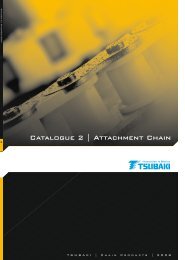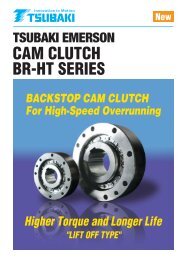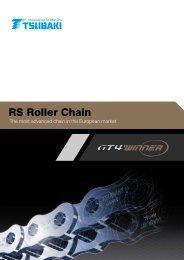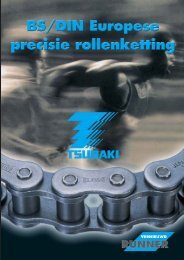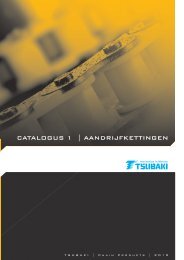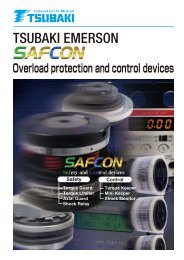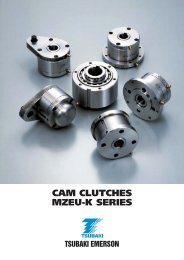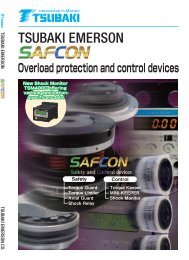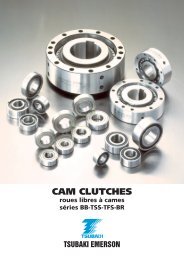Cat. 3 Custom Made Chain - Tsubaki Europe
Cat. 3 Custom Made Chain - Tsubaki Europe
Cat. 3 Custom Made Chain - Tsubaki Europe
You also want an ePaper? Increase the reach of your titles
YUMPU automatically turns print PDFs into web optimized ePapers that Google loves.
Temperature Selection MethodThis selection method is for chains that may experience strengthdegradation from temperature. Additionally, lubrication shouldbe carried out using a suitable lubricant according to the operatingtemperatures.High TemperatureWhen chains are used in high temperatures, the followingproblems may occur:• Increased wear due to decreased hardness.• Poor articulation and increased wear due to lubricant deteriorationand carbonization.• Stiff joints and increased wear due to oxide scale formation.• Increased elongation due to softening.• Decreased strength.To prevent lubricant deterioration at high temperatures, use aspecial lubricant.When chains are used in temperatures above 250°C, pay specialattention to the composition and heat-treatment of the chain.The most popular type of chain for high temperature is SS-specification,which is made of 304 stainless steel and has a maximumworking temperature of 650°C at low speeds. However, tomaintain an adequate safety margin at a high temperature likethis, we suggest you to use NS-specification chain. NS chain ismade of 316 stainless steel, which contains molybdenum andless carbon. NS-specification has worked at low speed in environmentsup to 700°C.If your operation runs at temperatures higher than 400°C, consult<strong>Tsubaki</strong> before making your chain selection. Production methodsand materials may be specially adapted for your application.Low TemperatureWhen chains are used in low temperatures, the followingproblems may occur:• Decreased shock strength due to low-temperature brittleness.• Lubricant solidification.• Stiff joints caused by frost or ice adhesion.Two types of chain are especially useful at lower temperatures.KT-specification chain is specially heat-treated to withstand verycold environments. SS-specification chain, which is made of 304stainless steel, may also be used at low temperatures. Low-temperaturebrittleness does not occur in austenitic stainless steel.These chains cannot fix the problems of solidification of the lubricantor stiff joints caused by frost or ice. Use cold-temperature oilor grease and apply it to the inner clearances and the outside ofthe chain.Standard engineered plastic chain can be run at temperaturesbetween -20°C and 80°C. At higher temperatures, it may becomesoft and not keep its shape; at lower temperatures it maybecome brittle.Standard Roller <strong>Chain</strong>KT Cold ResistantTemperature upto 1” pitch 1” pitch and over <strong>Chain</strong>* ss, NS, AS <strong>Chain</strong>Below - 60°C - - unusable -- 60°C to - 50°C - - MAL / 2 -- 50°C to - 40°C - unusable MAL / 1.5 unusable- 40°C to - 30°C unusable MAL / 4 MAL MAL- 30°C to - 20°C MAL / 4 MAL / 3 MAL MAL- 20°C to - 10°C MAL / 3 MAL / 2 MAL MAL- 10°C to 60°C MAL MAL MAL MAL60°C to 150°C MAL MAL unusable MAL150°C to 200°C MAL / 1.3 MAL / 1.3 - MAL200°C to 250°C MAL / 2 MAL / 2 - MAL250°C to 400°C unusable unusable - MAL400°C to 500°C - - - MAL / 1.2500°C to 600°C - - - MAL / 1.5600°C to 700°C - - - MAL / 1.8above 700°C - - - unusableNotes:* KT Cold Resistant <strong>Chain</strong>: <strong>Made</strong> to order.The ambient temperature is different from the temperature of the roller chain itself.MAL = Maximum Allowable Load. For details contact <strong>Tsubaki</strong>.Innovation in Motion 79



